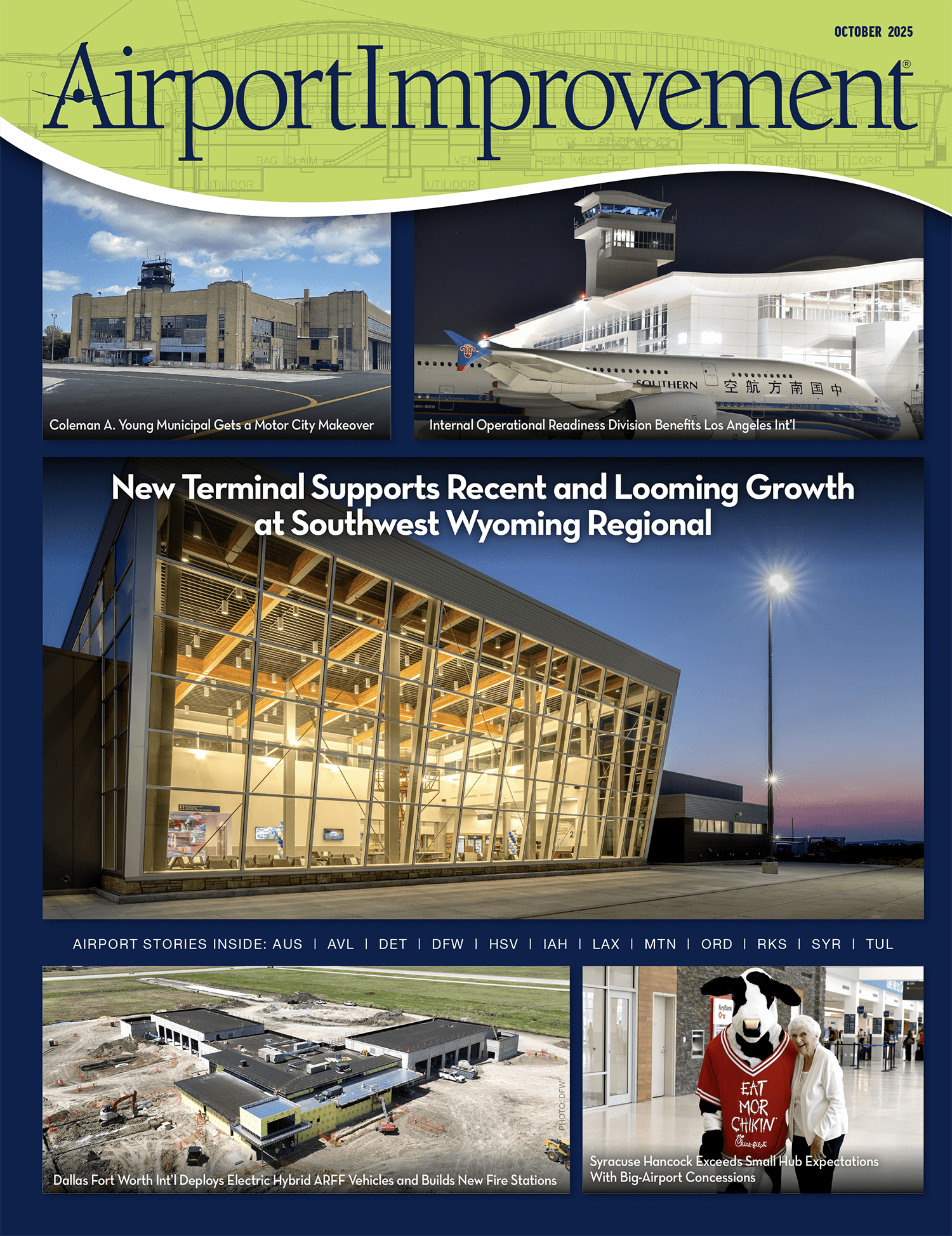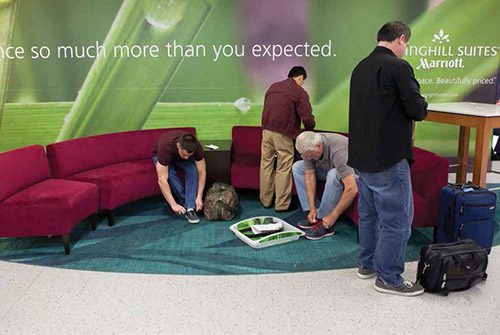 It wouldn’t be hyperbole or marketing hype to say that the newly renovated TSA checkpoint at Dallas/Fort Worth International (DFW) puts most airport screening areas to shame. The 3,000-square-foot screening station in Terminal E features soft music, mood lighting, oversized artwork, a video wall and other style-conscious décor. Beyond the X-ray machines, passengers don’t stoop and wobble awkwardly to put on their shoes and repack carry-ons. They sit on plush couches or stand at tall tables in a specially designed “re-composure area.”
It wouldn’t be hyperbole or marketing hype to say that the newly renovated TSA checkpoint at Dallas/Fort Worth International (DFW) puts most airport screening areas to shame. The 3,000-square-foot screening station in Terminal E features soft music, mood lighting, oversized artwork, a video wall and other style-conscious décor. Beyond the X-ray machines, passengers don’t stoop and wobble awkwardly to put on their shoes and repack carry-ons. They sit on plush couches or stand at tall tables in a specially designed “re-composure area.”

facts figuresProject: Security Checkpoint Renovation Location: Dallas/Fort Worth Int’l Airport Checkpoint: Terminal E, Gate E18 Noteworthy Features: Hotel-style furniture & artwork; LED lighting; oversized artwork; mood music; re-composure area; queue management system; improved sound system; new containers for passenger belongings Cost: $500,000 (including sponsorship fee) Funding & Design: SpringHill Suites by Marriott Project Management: SecurityPoint Media Program Execution: Aviator North America Lead Media & Creative Agencies: MEC; McGarry Bowen; Ferocious Cow Project Duration: 3 months Checkpoint Debut: Oct. 1, 2013 Airport-Funded Change: 1,500 sq. ft. expansion Queue Management Tool: Qmetrix, by XIMES Stanchions: Beltrac, by Lavi Industries Audio System: Panphonics Sound Shower Passenger Belonging Containers: SecureTray Key Benefits: Enhanced customer service; increased throughput |
The new customer comforts debuted in October cost approximately $500,000 — and DFW didn’t pay a penny for them. In fact, the airport collected a sponsorship fee for allowing SpringHill Suites by Marriott to infuse the checkpoint with hotel styling and advertise in the upgraded space.
Travelers passing through the checkpoint now describe it as “hotel-like” — and that’s just what DFW was shooting for.
“Hotels are all about hospitality – welcoming their guests and making them feel at home,” explains Michael Baldwin, the airport’s assistant vice president of concessions. “That is part of what we do at DFW. We want to welcome guests. We want them to know that we want them to be here. We need them to be here. We want them to feel comfortable and to have a good experience and good take-aways from DFW.”
SecurityPoint Media, an agency that specializes in airport checkpoint advertising, connected DFW with SpringHill Suites and collected a commission for its matchmaking and project management services.
Unique Partnership
Before the hotel company performed its checkpoint makeover, DFW made operational improvements and doubled the overall size of the TSA screening area near Gate E18 during a recent 50,000-square-foot expansion of Terminal E. The project was a small component of a $2.3 billion program to renovate and “redefine the airport experience” in DFW’s four original terminals.
“(The checkpoint expansion) provides us the square footage that we need to provide adequate queuing areas and divestiture lanes,” explains Bob Blankenship, DFW’s assistant vice president of planning.
Just as DFW was considering its next step in the project, SecurityPoint Media approached the airport’s concessions staff. After learning about the airport’s mission to create a new level of passenger comfort, SecurityPoint Media suggested that DFW might be able to secure third-party sponsorship for checkpoint enhancements. SpringHill Suites, it seems, was interested in transforming a real-world experience encountered by travelers to promote its hotel brand.
The airport security area seemed like the perfect place to bring unexpected and positive enhancements,” explains Craig Fowler, Marriott’s senior director of brand marketing, select service brands. Infusing the checkpoint with hotel hospitality and styling created an “antidote to the stress of business travel,” he explains.
The cooperative checkpoint project that resulted is a life-sized, working demonstration of SpringHill’s advertising campaign, which asks: “What if everywhere you went, you experienced so much more than you expected?”
DFW dubbed the three-month checkpoint pilot “The Next Level Experience” and defined its goals: exceed passenger expectations by improving communications, enhancing the physical environment and adding customer conveniences.
Joseph T. Ambrefe, Jr., president and chief executive officer of SecurityPoint Media, credits executives at DFW for their role in the project: “They were willing to execute a first-in-class program in the industry in the U.S. – and consider how the space around the checkpoint can be transformed to bridge the service gap.
“DFW had a clear vision for what it wanted,” he continues. “Bringing SpringHill Suites in as a sponsor with a shared vision was critical for generating revenue in the space and being able to connect in a relevant way with their target demographic. The great thing about the project is that all the stakeholders were aligned.”
The overall goal was to improve the checkpoint experience by putting customer service front and center, he explains. A wall graphic in the re-composure area summarizes DFW’s objective and reinforces SpringHill’s ad campaign: “Experience so much more than you expected.”
According to Fowler, feedback from travelers about the recently renovated checkpoint has been overwhelmingly positive. “To witness travelers smiling while using the re-composure area or enjoying the video wall while moving through the zone is very satisfying,” he comments.
DFW is the first of two airports transformed by SpringHill Suites; Charlotte-Douglas International Airport in North Carolina is the other.
Creating a Hotel Feel
Blankenship describes DFW’s previous Terminal E checkpoint as “functional, but cold and  unwelcoming.” These days, soft, color-changing LEDs replace bright white fluorescent lights; once-bare halls are adorned with colorful pictures of larger-than-life flowers, ferns and hotel views.
unwelcoming.” These days, soft, color-changing LEDs replace bright white fluorescent lights; once-bare halls are adorned with colorful pictures of larger-than-life flowers, ferns and hotel views.
“The enhancements really made a major improvement to how the customer feels welcome at DFW airport,” Blankenship reports. “It’s a much more relaxed feeling.”
Replicating the comforting feel of a SpringHill Suites hotel in a post-security airport environment was more complex than challenging, says Erik Bottema, Aviator North America managing director. (Aviator is Marriott’s media agency partner in the aviation market.)
To do so, designers used many of the hotel’s finishing elements and materials in the checkpoint. Chairs, tables, couches, carpet, wall colors and even some hardware pieces are identical at both locations. Passengers who don’t recognize the SpringHill Suites look and feel will find the hotel’s name and brand identifiers on wall wraps and banners at the checkpoint. Signs with the hotel’s logo encourage passengers to “Feel refreshed” and “Feel inspired.”
New Efficiencies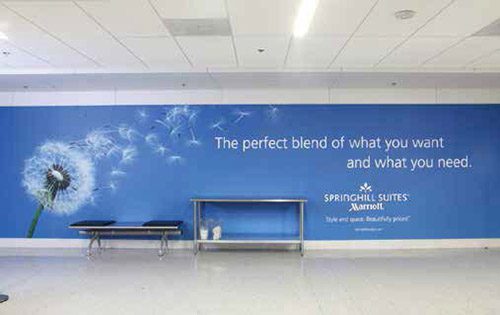
According to Blankenship, SpringHill’s subconscious stress-reducing elements have helped increase throughput at the renovated checkpoint. Wait times have decreased because people are going through faster, he explains.
Specifically how long will a passenger need to wait? DFW recently installed a queue management tool to provide that answer. Qmetrix, by XIMES, provides an estimate to each passenger as he or she enters the security checkpoint area. “We thought that it was really important to manage expectations,” Blankenship relates.
While watching the airport’s new system in action, he recently heard a woman mutter, “It’s going to take me 20 minutes to get through,” as she entered the checkpoint. The queue management system, however, estimated her wait time at 10 minutes. Using his watch, Blankenship timed the woman going through in eight minutes.
 “The Qmetrix queue management system is incredibly accurate,” he notes.
“The Qmetrix queue management system is incredibly accurate,” he notes.
The system is made up of wireless queue sensors integrated into a Lavi Industries Beltrac stanchion system, a data radio and a web-based dashboard. The sensors count customers in and out of a waiting queue by using infrared beam-break technology. Data collected by the sensors is available in real-time and can be used to create key performance indicators and reports.
According to SecurityPoint, which managed both projects, DFW is the second U.S. airport to install the queue management system.
Improving Communications
While some airport checkpoints have more signs than passengers could possibly read, DFW’s E18 checkpoint doesn’t have a single one. It displays screening and other information on 40-inch, flat panel monitors. “We are a TV society,” Blankenship explains.
Dynamic, targeted messaging tells passengers how to prepare for screening and delivers information about terminal concessions, services and SpringHill Suites. “Even though the (TSA) rules have been around for years and years, you would be surprised how many people don’t remember to take their shoes off or take their electronics out,” Blankenship remarks.
Since DFW implemented the media change, passengers are now better prepared for the security process, he adds.
Security instructions are also delivered audibly, via a Panphonics Sound Shower® with directional speakers that are 2 feet square and resemble an air vent. Five speakers positioned in the beginning of the queue play pop/alternative music from the SpringHill Suites stations on Pandora Internet Radio. Another speaker located over the first divestiture lane plays instructional messages for travelers.
Ryo Kumagai, from the Panphonics sales office in Helsinki, Finland, says that DFW’s directional audio system is specifically designed to attract the attention of passengers waiting in the queue without subjecting airport workers to the same instructions over and over. With pre-recorded messages, TSA agents no longer need to yell out instructions repeatedly, Kumagai adds. 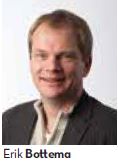
Trays vs. Bins
The overhauled checkpoint at DFW uses 320 new containers for carry-on bags and passenger belongings such as pocket change, keys, shoes and other items that must pass through X-ray machines. The SecureTrays®, created by SecurityPoint Media, are 20% larger than the company’s previous containers but have low sides to discourage passengers from stacking items on top of one another. The SecureTray System includes plastic trays, carts to move them and stainless steel divesting tables. Although the system is used at more than 40 major U.S. airports, DFW is the first to use the larger trays, reports Ambrefe.
Like all SecureTrays, the units at DFW have a tether ID number to help track passenger belongings and prevent loss. The numbers at DFW’s checkpoint are radio opaque, so they can be viewed with or without X-rays.
While bins at many airports include advertisements, DFW’s have colorful nature images that complement the checkpoint’s new wall art.
Worth Repeating
TSA personnel declined to weigh in about DFW’s recent checkpoint enhancements, noting that they don’t comment on private ventures. The administration did, however, reiterate its ongoing efforts to move away from a “one-size-fits-all approach to transportation security.”
Although the “Next Level” pilot was officially still under evaluation at press time, early reviews of the new checkpoint were positive. “Based on informal interviews with passengers and employers, and just observations, we feel really good about the program,” Baldwin reports. “Our executives feel so good about it, they said we are not going back.”
Moving forward, however, will require funding. And it remains to be seen whether funds will be provided through sponsorships or by the airport. DFW does, however, look to implement the program at all 16 checkpoints, in five different terminals, reports Baldwin. The A12 and international checkpoints are currently top priorities.
It is also yet to be determined whether the airport will partner with SecurityPoint Media for subsequent checkpoint projects. “We’re really bullish on the opportunity to help airports think through how to improve the security checkpoint environment,” says Ambrefe. “We want to help add a level of customer service, while keeping a critical eye on the security mission.”
According to Ambrefe, it’s time for airports to begin viewing security as a service opportunity. “With that in mind, things like environment and how people feel when they’re waiting in line come into play,” he explains.
Ongoing Checkpoint Improvements 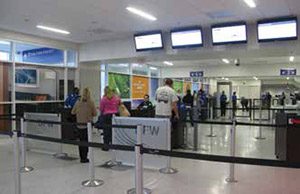
Realizing that TSA screening is a critical part of the overall passenger experience, Dallas/Fort Worth International Airport (DFW) continuously monitors performance at the 16 checkpoints in its five terminals. Almost a decade ago, DFW officials became concerned that wait times were becoming excessive. In 2005, the airport began partnering with TSA in 2005 to process passengers more efficiently — without adding equipment or TSA officers. “What we have found over the years is that as security procedures change, they typically require more square footage,” says Bob Blankenship, assistant vice president of planning at DFW. “We got to the point where there was no more square footage.” Operating as an in-house consultant, the DFW Planning Department conducted a study about the airport’s checkpoint throughput and recommended a number of operational improvements. While many airports have passengers form a single line at each screening machine, DFW uses both sides of divesting tables to expedite traffic flow into each X-ray machine. If one line is held up, the other can keep moving. The airport also uses both audio and visual messaging to move passengers along. Visual monitors in the queue area display custom-made explanations of how to divest. Audio messaging at the divesting tables provides friendly reminders, so the TSA agents don’t have to. With these changes, throughput capacity (as measured by per lane averages) increased by about 34%. On average, capacity improved by about 200 passengers per lane, per hour throughout the airport. DFW also expanded some checkpoints as part of its Terminal Renewal and Improvement Program, a $2.3 billion project designed to renovate and redefine the airport experience in its four original terminals. “We took that opportunity to design what we considered the ideal security checkpoint,” Blankenship explains. Not stopping with additional square footage, DFW officials continued to evaluate what they could do to enhance the customer experience. That’s when The Next Level Experience was developed. DFW was also among the first airports to test the TSA PreP™ program, which expedites screening for low-risk travelers. Under the program, pre-approved airline travelers may be allowed to leave on their shoes, light outerwear and belts; keep laptops in their cases; and leave allowable liquids and gels bag in their carry-on baggage.
TSA has since expanded the program to more than 100 airports nationwide and is currently in the process of opening more than 300 enrollment centers in terminals across the country. As enrollment centers open, all U.S. travelers and lawful permanent residents will be able to apply directly for expedited screening privileges. |


